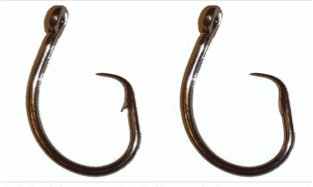(This is part III of a IV part series on Barbless Circle Hooks. Catch up on Part I and Part II)
In my last post, I talked about my sadness in seeing so many large hooks in sharks and turtles around O’ahu. I’m told this also happens to our critically endangered Hawaiian Monk Seals as well – a tragedy on every level. In that post, I also talked about the damage that J hooks can do to marine life that aren’t intended for dinner – often causing unnecessary and fatal injuries to wildlife. For these reasons, I’m greatly in favour of using inline circle hooks over J hooks or offset circle hooks (sound like gobbley gook? Read this first) But when an animal is hooked, the issue still remains, how to get the hook out? Un-shed hooks can present danger to wildlife even if they are not deep hooked. Some hooks are disproportionately large and can prevent feeding among other things. So for this post, I wanted to talk about a really great thing – barbless circle hooks.

Most non-fishermen know fishing hooks to have a nasty little barb on the tip (left image). Most fishermen who have used them are quite aware of how much damage that barb can do to a finger that got in the way. The barb is designed to prevent the hook from coming out – works the same way on a fisherman too! Kiddie-drawings and story books and received wisdom all show us barbs on hooks. But it turns out


the barb is neither necessary, nor present on early hooks; fishing hooks used to all be barbless! The thinking is that the barb was initially introduced to keep live bait on the hook, and even then, only many thousands of years later. With all the maker and foodie trends going back to traditional approaches, the idea of returning to barbless hooks seems positively hip.
Benefits
There are many benefits to using barbless circle hooks. In my last post I briefly discussed why circle hooks are the way to go, so here let’s just look at why barbless circle hooks are the better hook. A quick summary list
- Lower mortality rate to fish (and therefore higher reproduction)
- Easier to extract from fish/sharks/turtles/seals if releasing
- Allows for quicker release of the fish back into the water
- Easier to remove from yourself if accidentally hooked
- More challenging to fish with (this, for a sportsman, is a good thing I’m told)
- Animals are more able to self-shed a barbless hook without waiting for it to rust off (NOAA now has proof of this!)
- Fish are able to continue feeding without a hook in the way
Hooray! Sounds great. More on this below.


Controversy
But before I get too excited, I should clarify that using barbless is still controversial. As with most things with a lot of pros, there are a few cons to be reckoned with. Barbless hooks
- Make it easier for the fish to unhook itself
- Requires different and more skills for success
- Takes time to crimp down the barbs (a manual process if your hooks are not already barbless)
There are a lot of articles written by experienced anglers that say they find no difference in success rate between the two hooks, and there are a lot of anglers that claim its far easier to retain a fish meant for the dinner table with the barb in place. Both are probably true. Here is what one experienced angler says about it –
“You have to be more conscious of the pressure and angles of the fish. You have to be aware of what the fish is doing and where it’s going in order to not provide that small amount of slack for the fish to throw the hook. To me that is a challenge and one that I look forward to. It adds another dimension to this sport that only adds to the enjoyment one has when out on the water.” –Clint Loos
As with nearly any body of knowledge like fishing, diving, even golfing, new tools and techniques will be accompanied by a new set of skills to be learned. If skilled and experienced fishermen are finding no change in their catch rates, why not give it a go? The final drawback is to do with availability – it seems that while barbed hooks are found in every tackle shop, not all carry barbless ones. Many anglers crimp their own which does take some time. But there are more barbless hooks on the market, especially as their use becomes more popular.
In the next post, I’ll take a look around benefits. (read part IV))
